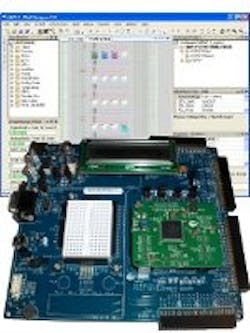Cypress Semiconductor's PSoC Development Kit
Cypress Semiconductor's PSoC Development Kit
Cypress Semiconductor's PSoC Development Kit
Cypress Semiconductor's PSoC is a neat family of microcontrollers that incorporate FPGA-like flexibility when it comes to peripherals. Essentially each chip comes with a run-time configurable set of digital and analog peripherals. The number of digital and analog blocks vary depending upon the chip. In addition to a selection of configurable peripherals, Cypress provides three base microcontroller architectures designated PSoC 1, PSoC 3, and PSoC 5.
PSoC 1 is the original 8-bit microcontroller of the PSoC family. It used a flexible proprietary architecture. It is still available but is quickly being superceeded by the 8051 PSoC 3.
The newer PSoC 3 8-bit architecture is based on the Intel 8051 architecture. This platform is popular because it is compatible with the 8051 and related tools. This makes migration of applications from other 8051 platforms significantly easier. Likewise, it opens up the use of third party development tools and compilers.
The PSoC 5 is based on the ARM Cortex-M3. The Cortex-M3 is an extremely popular 32-bit platform.
The following is a quick summary of development kits available for the PSoC line as well as the software development tools from Cypress. Check out the PSoC Development Hardware and PSoC Development Software articles for a hands-on look at the tools.
PSoC Hardware
The $49 PSoC FirstTouch Starter Kits are available for the PSoC-3 (CY8CKIT-003) and the PSoC 5 (CY8CKIT-014). The FirstTouch Starter Kits are essentially identical with a different processor chip on-board. Each kit comes with the processor board, a 9V battery, USB cable and a CD with documentation and software. The boards support USB-based debugging and have an accelerometer, thermistor, proximity sensing, and a CapSense touch-sensing interface. There is a 12-pin wireless module header that works with Cypress supplied modules. The board also brings out 28 general purpose I/O pins via a standard DIP header.
The PSoC 1 kit is USB-based and has been available for a number of years.
The $249 PSoC Development Kit (CY8CKIT-001) is a more substantial system that accepts plug-in modules with the processor. The kit comes with PSoC 1, PSoC 3 and PSoC 5 modules. The host board includes a breakout board. There is a 12V power adapter and USB cable for debugging. This platform provides a more robust development environment although it uses the same software development tools.
PSoC Software
Cypress Semiconductor provides two tools to address hardware configuration and software development. These include PSoC Creator and PSoC Designer.
PSoC Creator is a rapid prototyping environment that can be utilized by developers may not embedded development experience. It takes advantage of the configurability of the PSoC hardware to deliver a wide range of predefined, configurable devices that can be wired together using the graphical development environment thereby creating an application that is ready to be deployed and tested on a PSoC platform.
PSoC Designer is a more conventional IDE that brings a graphical, schematic design environment for hardware configuration as well as a software development tool for assembler and C/C++ application development. Developers can use one or both aspects of the tool depending upon their design requirements. The hardware and software sides work together so the interface details for a selected hardware configuration incorporate the respective header definitions for the software.
About the Author
William G. Wong
Senior Content Director - Electronic Design and Microwaves & RF
I am Editor of Electronic Design focusing on embedded, software, and systems. As Senior Content Director, I also manage Microwaves & RF and I work with a great team of editors to provide engineers, programmers, developers and technical managers with interesting and useful articles and videos on a regular basis. Check out our free newsletters to see the latest content.
You can send press releases for new products for possible coverage on the website. I am also interested in receiving contributed articles for publishing on our website. Use our template and send to me along with a signed release form.
Check out my blog, AltEmbedded on Electronic Design, as well as his latest articles on this site that are listed below.
You can visit my social media via these links:
- AltEmbedded on Electronic Design
- Bill Wong on Facebook
- @AltEmbedded on Twitter
- Bill Wong on LinkedIn
I earned a Bachelor of Electrical Engineering at the Georgia Institute of Technology and a Masters in Computer Science from Rutgers University. I still do a bit of programming using everything from C and C++ to Rust and Ada/SPARK. I do a bit of PHP programming for Drupal websites. I have posted a few Drupal modules.
I still get a hand on software and electronic hardware. Some of this can be found on our Kit Close-Up video series. You can also see me on many of our TechXchange Talk videos. I am interested in a range of projects from robotics to artificial intelligence.

